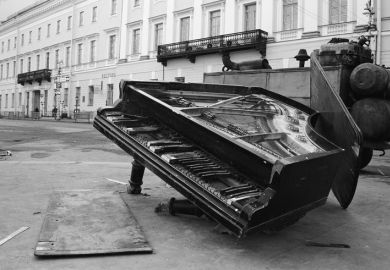This is a remarkably balanced, wonderfully objective book. While exposing the betrayal of a sacred and noble art by vulgarisation, and exploitation, the book nonetheless leaves the reader with a certain sense of progress and hope.
Indian Music and the West offers stimulating analysis of musical trends and fashions, both scholarly and corrupt. It explores the field from every angle, historical, social and commercial, contextualising a music and a style of music making that is a most sensitive and expressive barometer of humankind's subconscious and conscious life.
The book weaves its way through the ancient musical heredity of the Khan family to the eruption of Gauhar Jan, the Armenian Jewess who launched Indian music into our age of mass media. The absorbed reader is enmeshed in a great tapestry that features the individuals who so profoundly marked the successive stages from the eclectic to the popular, before finally confronting these basically incompatible approaches in the person of Ravi Shankar. Shankar was true to his tradition and at the same time adaptable to the current ethos of supreme artist performer and teacher-cum-household-idol.
Civilisations are bound together through curiosity, friction and abuse in that vast cauldron of "world music" out of which the primary elements of rhythm, mode, melody counterpoint and harmony emerge again in various incarnations - "reified", as the author repeatedly says.
The book pursues the many implications of this fact: the undertows of Africa and Asia, the Islamic currents, in the changing character of India's great musical tradition, evolving and nurtured over the centuries in meditative complexities and convolutions - mathematical and modal, theoretical and aural - and based on an enormous accretion of theoretical, structural and performing experience. It describes how this tradition met its western opposite, becoming impure, chromatic, harmonic, melodically trapped by vertical intervals, the horizontal flow subjected to this vertical axis and to an ebbing sense of rhythmic variation.
Today we seem to unite basically in the hectic and deadly monotony of "beat", of pulse, sometimes fortunately yielding to the uneven and more complex time signatures of the oppressed and despised - blacks, East Europeans, Middle Easterners and, above all, to the calculated, mentally computerised rhythms of India, as involved as are the myriad alternatives of chess.
The book does not touch on the great linking thread between India and Spain, that connects the musical nomads of Rajasthan via the Gypsies to the music of Andalusia. These bees of cross-fertilisation, flying between the flowers of pain, nostalgia and freedom, produced that ultimate "people's" art, the flamenco, which absorbed also Jewish and North African elements. It is without doubt the most poignant expression of human torment and of the determination to live of any "natural", un-notated music and dance that I know.
Fortunately, modern electronics allow us to record music accurately, for the first time, in pitch, in time, in dynamics, so we can "see" a performance. But such graphic images can never fully communicate performance. If notation were equal to performance, the interpreter would be unnecessary, no more than a reading machine.
Of course, as a violinist I have always been intrigued by the Indians' adaptation of the European violin - the most perfect bowed instrument - to their own music some 200 years ago and by the country's superb violinists.
I was most amused to discover from the book that my old friend Fred Gaisberg of GTL(Gramophone and Typewriter Ltd), who pioneered the professional recording of Indian music in India in 1902, was the Fred Gaisberg of HMV, who conceived that genial idea, my English blessing, of my recording the Elgar "Violin Concerto" with the composer himself in 1932. I wonder if by that time his appreciation of music had equalled his commercial acumen?
In 1953 EMI London turned down the first recording of "West Meets East" I proposed to do in New York with Ali Akbar Khan when I first presented Indian classical music to American audiences on television. Fortunately, the local EMI agent agreed to do it.
I was, of course, merely a modest successor of Ruth St Denis and Pavlova - but by my time it was possible to be a respectful pupil of a great teacher, Ravi Shankar, and to play, however simply, authentic Indian classical music. I was followed in this by George Harrison, John Coltrane and others. The experience remains one of the most enriching and fascinating of my life. I did not learn formulas, I lived in Ravi's imagination.
Indian Music and the West documents the history of a most important strand in the evolution of our music today. It is entertaining, informative, humorous and readable.
Lord Menuhin first toured India as a violinist in 1952.
Indian Music and the West
Author - Gerry Farrell
ISBN - 0 19 816391 6
Publisher - Clarendon Press, Oxford
Price - £32.50
Pages - 241
Register to continue
Why register?
- Registration is free and only takes a moment
- Once registered, you can read 3 articles a month
- Sign up for our newsletter
Subscribe
Or subscribe for unlimited access to:
- Unlimited access to news, views, insights & reviews
- Digital editions
- Digital access to THE’s university and college rankings analysis
Already registered or a current subscriber? Login



